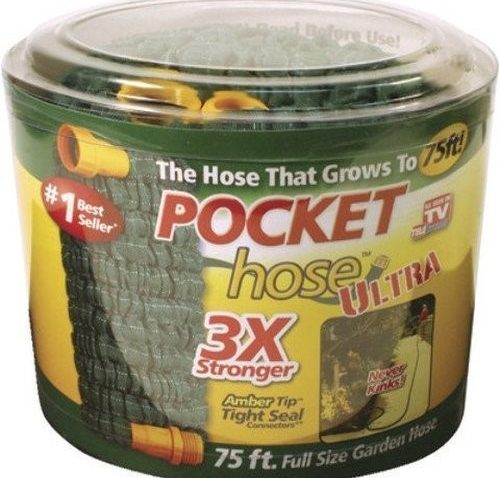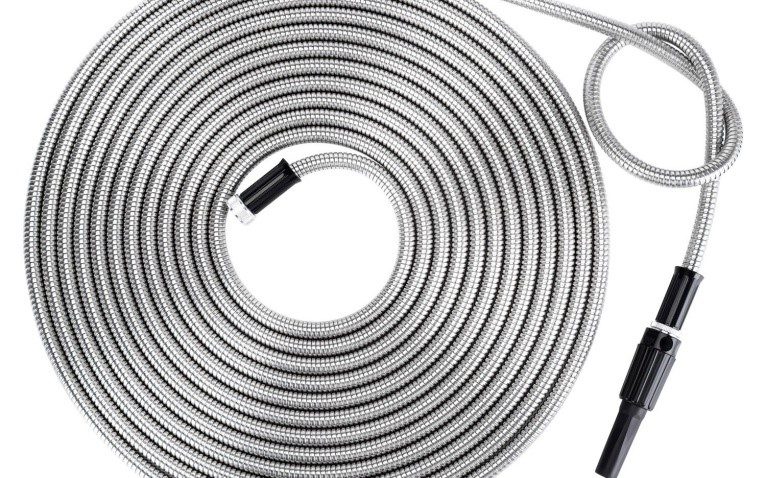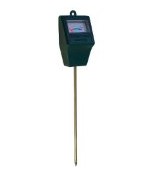
by Stan Logan | Mar 19, 2020 | Garden tools, Irrigation
What can you say about hoses? That’s what I asked myself when it was suggested I do an article about hoses. I’ve been pondering this question for several months now. I have some thoughts that are possibly worth sharing . . . or not.
The most basic rule as with practically all things you buy: “You get what you pay for.” If you buy a cheap hose, you will likely have problems with kinking, the fittings will eventually leak, and the hose material will not bear up against the ravaging of the sun’s rays. Other than this obvious cost consideration, there are other decisions to make.
Most garden hoses have a 5/8 inch inside diameter. ½ inch hoses are lighter, have reduced volume flow, and are generally of low quality. How much length do you need? Most hoses are 50 feet long. I’ve noticed a long monster for sale at Costco.

Pocket hose
You must have noticed the “Pocket Hose” or the other numerous expandable hose brands that seems to be the latest hot item on the hose market. You can find it for sale in a container about the size of a lunch box. You have to use one of these to appreciate them. It weighs almost nothing, so if aging muscles have difficulty dragging a heavy hose around, this may be the hose for you. You don’t have to worry about knocking things down as you drag the hose because it doesn’t ever lie in stiff loops on the ground. When you release the pressure, the hose shrivels up to almost nothing and can be stored in a large flower pot. However, these hoses are notorious for developing leaks in a very short time. They have come out with supposedly improved models. I have to admit that I bought one of these Pocket Hoses at Target because it was on clearance for $14—I can’t resist a sale. The regular price is over $30. You see, I had found a Pocket Hose at a garage sale months ago, and LaVille really loves it. It developed a leak next to a fitting, but I was able to fix it. I think it will be only a matter of time before her hose is a goner, but now I have a back-up. I figured that $14 for a hose that my wife loves for one year is worth it. If you choose to also gamble, don’t leave the pressure on after use. Also, stepping on it can result is premature death . . of the hose, that is.
Then there is the stainless steel hose that has recently appeared. If you believe all the hype, this is the hose of the future . . or not. Since I knew nothing about these hoses, I looked at the comments for the different models you can buy on Amazon. I hope you have used consumer comments to help you select products when you buy online. These comments are often very revealing and often amusing. Among the comments about these hoses were many complaints about the low volume flow and frequent leaks—but these varied a great deal from brand to brand. It once again revealed the fact that you get what you pay for.

Steel Hose
How about coiled hoses? I hate coiled hoses. If they don’t result in premature death from tripping on them, they will cause a heart attack for all the stress they create when they get tangled or hung up on something. Volume flow is low. These stupid hoses do not last very long either. That being said, we have one of these . . I don’t know why . . except they do recoil into a relatively small space. Actually, my proof reader says she likes this hose and uses it more than any other hose. And here I was ready to pull out that Pocket Hose that I was saving for a leaky day.
Hope you’re a happy hoser,
Stan, The Tool Man

by Stan Logan | Mar 19, 2020 | Garden tools, Irrigation

Garden Timer
I know you have run a sprinkler or hose in the garden and expected to remember to turn it off in a certain time. If you remembered 90% of the time, that would be remarkable. It’s the 10% when you forget and waste all that precious water when you have fought so hard to save every drop. The tool that will remove this frustration is the garden timer. So, you’ve never heard of a garden timer? A garden timer is a device otherwise known as a kitchen timer, but when you are in the garden, it’s a garden timer. I used to carry one of those timers that you twist to set a certain number of minutes. It took a large sweatshirt pocket to house this device. Then I saw the very small digital timer sold in the kitchen gadget section of Target. For about $7, you too can own your own tiny timing device. Perhaps you would be more comfortable calling his tool a “personal timer” because there are some many instances in your daily routines that require reminders.
Now I know most of you have a smart phone, and it is easy to tell it to set an alarm, but I think it is easier to use this tool to make you a more responsible person in your garden and in your personal life.
Trying to reduce your regretful moments,
Stan, The Tool Man

by Stan Logan | Mar 19, 2020 | Garden pests, Garden tools, Irrigation

bucket
Body count tonight: 57. I remembered just before going to bed that the snails would be out in force since it rained a little today. I grabbed a flashlight and my snail masher from behind the front door. It consists of an old cut off flagstaff with a 2 x 2 block attached at the end. The grandkids use it when they visit and earn 5 cents per snail killed.
I don’t understand why snails come out from their leafy protection and crawl around exposed on pavement and pavers. I actual feel guilty murdering helpless snail after snail. You really can’t call the exercise “snail hunting” because that would indicate that some sort of sport would be involved. Perhaps, if you were a snail hunter, you shouldn’t be able to kill a snail unless it is in flight. LaVille said that she’s seen snails take flight. She and her siblings would visit an aunt in Salinas and collect snails and then return home to Calexico where they would place them on hot pavement to see how high they could fly. Perhaps snail hunting should be restricted from ½ hour after sunset to ½ hour before sunrise. Snail hunting season would be limited to the winter months. You wouldn’t want to kill snails during their breeding season. Of course no artificial light source could be used. To make the sport more fair to the snail, size of the snail masher could limited to a ¼ inch diameter rod. Naturally no snail with a shell diameter less than 1 inch could be harmed. Chemical products of any sort would be outlawed.
I’m considering starting a club called “Snails Unlimited”. Would you like to join me in protecting the lives of these helpless mollusks. Let’s ensure that the sport of snail hunting is available to be enjoyed by future generations.
Stan, The Snail Killer
P.S. LaVille suggested an addendum was needed here:
When we had rounded up a significant collection of these hermaphroditic herbivores, LaVille would take them into her classroom and distribute them in small paper bags as pets to her students for responsibility training (for the kids). Then periodically she would hold races on the overhead projector by placing these snails in the center to see which sprinter could reach the periphery first.
I have to caution you however: Do not store your collection of snails in a paper bag. They will eat their way out and you will find estivating snails all over the house for weeks. Trust me
by Stan Logan | Mar 19, 2020 | Irrigation
Now here’s a system that you may wish to consider. I’ve used rain barrels for almost 40 years—not because I was trying to conserve water—but because Davis city water was so terrible. It was so bad that the City was forced to obtain Sacramento River water. You might have heard that Davis, UCD, and Woodland allocated millions of dollars on a river water project. Our well water was so bad that even if not affected by users, the “clean” water could not be returned to the River. It didn’t meet new environmental standards.
Gardeners depended on the winter rains to push those toxic minerals down through the soil. But if you had a planting area beneath eaves, or you had indoor plants, you had a problem. So we used rain rain water from barrels for a long time to flush this soil.
Lately though, I’ve been using rain barrels to divert water run-off from the roof from areas I don’t want water to areas that I do want extra water—specifically to the drip line of a huge hackberry tree, pine tree, and several citrus trees. If a water diversion plan appeals to you, here is what you might consider doing:
- Remove a down spout. Cut off 18” from the top of the removed section. Slip that short section back into place.
- Purchase a thin 8 foot plastic down spout extender. I bought mine at Ace Hardware. They are available at Amazon Prime for about $7.
- Attach the end of the flexible tube not containing holes to the 18” section.
- Cut another 18” off of the original removed downspout. Attach this piece to the end of the flexible tube that is hanging down. The piece of downspout that you just attached will simply serve as a weight to keep the plastic tube in whatever barrel or container you place it. You may wish to cut off a section of the plastic tube. My downspout extender does not reach the ground. Don’t worry about the little holes punched in the side of the plastic tube—water loss will be minimal.
- Now you have a down spout extender that can be moved from barrel to barrel or to a wheelbarrow—whatever
Now if you want to get fancy:
- Drill a hole in the bottom of the side of your barrel or garbage can and buy a PVC fitting that create an attachment for a hose. Now you can lead the rain water where ever you want. By adding a section of tubing like old soaker hose with holes drilled in it, you can disperse the water along a planting bed protected by an eave, or where trees need to be deep watered.
- Not fancy, but plug the other down spouts that are on that same gutter (a rolled up sock works well). Make sure that your gutter can bear the weight of being full.
- Have some kind of cover for your containers. We use an extra large size leaf bag.
Realize that your water containers are going to remain in place for a long time. Elevation is also a consideration. Gravity feed will not lead water to higher levels of your landscape, but a sump pump would.
Well, that’s the system I’ve used. You might consider creating your own system not soley just to conserve water, but to transfer rain water from where you don’t want it to where you do want it.
If you are still interested, google “rain barrels” and you will find a tremendous variety of productrs that are available.
Stan, The Tool (or Device) Man

by Stan Logan | Mar 19, 2020 | Garden tools, Irrigation
Kill any plants lately? If so, it was probably because of too little or too much water. The tool you need is the moisture meter. Now, one of the guest speakers (the “Giggling Gardener”, I believe) on the Farmer Fred radio show said that each of us has a moisture meter on each hand. But, honestly, I don’t like jamming my finger down into the soil. I hate dirt under my fingernails. Then too, sometimes even a long finger can’t get through the plant to reach the soil.
Many moisture meters come with 2 probes. I personally find the additional metering of pH and light useless. A second probe also makes it twice as hard to penetrate the soil. Moisture meters are available at garden centers and nurseries for about $10. If you can only find 2 probe models, I suggest you snip off the second probe. Are you really ever going to adjust the pH of your soil? Dip each probe separately into water to see which one detects moisture. Don’t leave the meter in soil between uses. Corrosion will reduce effectiveness. If corrosion appears, use steel wool or fine sandpaper to clean the probe.
I believe most of you have potted plants, and it is those plants that are susceptible to over or under watering. Whether it is potted irises, violets, cyclamen, ferns, or Chinese evergreens, soil moisture needs to be monitored. By the way, you do realize the proper way to water a potted plant is to apply water until it runs out the bottom. That will reduce the buildup of minerals in the soil. Another tip is to beware of drip basins. Water left in a drip basin will cause soil to remain saturated resulting in root rot because of a lack of oxygen.
Keeping potting soil moist can also result in the culture of soil or fungus gnats. These are tiny (like 1/8 in) flies that arise from the soil of indoor potted plants when watered or otherwise disturbed. The flying adults are harmless, but it is the larval stage that can do damage by eating the roots hairs of your plants. Here you can use your moisture meter to monitor soil moisture. Allow the top layer of the potting mix to dry out between watering. This will simply break the life cycle of this pest without the application of various chemical products that are available. Watering from the bottom up is another technique to keep the soil surface dry.
Moisture meters are common in nurseries and can be purchased on Amazon for less than $10. I encourage you to leave the moisture meter somewhere in the house where you will come across it frequently to remind you to check your potted plants. Believe me, you will kill fewer plants by using this simple device.
Keeping my fingers clean,
Stan, The Tool Man







